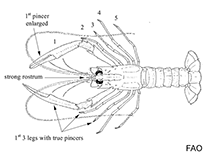Nephropsis occidentalis Faxon, 1893
Pacific lobsterette| Native range | All suitable habitat | Point map | Year 2050 |

|
| This map was computer-generated and has not yet been reviewed. |
| Nephropsis occidentalis AquaMaps Data sources: GBIF OBIS |
Upload your photos
Google image | No image available for this species;
drawing shows typical species in Nephropidae.
Google image | No image available for this species;
drawing shows typical species in Nephropidae.
Classification / Names Common names | Synonyms | CoL | ITIS | WoRMS
Malacostraca | Decapoda | Nephropidae
Environment: milieu / climate zone / depth range / distribution range Ecology
Benthic; depth range 300 - 1200 m. Tropical; 28°N - 33°S, 117°W - 90°W (Ref. 4)
Distribution Countries | FAO areas | Ecosystems | Occurrences | Introductions
Eastern Pacific: Mexico to Chile. It was pointed out that the records from the Galapagos and Marion Islands are erroneous (Ref. 106).
Length at first maturity / Size / Weight / Age
Maturity: Lm ? range ? - ? cm Max length : 13.0 cm TL male/unsexed; (Ref. 122061)
It has lengths of 5 to 13 cm, total length; 3 cm, carapace length; It was said that a published record giving the maximum length as 25 cm is clearly erroneous (Ref. 4). Occurs at depths of 300 to 1200 m with muddy or sandy bottom (Ref. 4).
Life cycle and mating behavior Maturity | Reproduction | Spawning | Eggs | Fecundity | Larvae
Members of the order Decapoda are mostly gonochoric. Mating behavior: Precopulatory courtship ritual is common (through olfactory and tactile cues); usually indirect sperm transfer.
Main reference
References | Coordinator | Collaborators
Holthuis, L.B. 1991. (Ref. 4)
IUCN Red List Status (Ref. 130435)
Least Concern (LC) ; Date assessed: 03 December 2009
CITES status (Ref. 108899)
Not Evaluated
CMS (Ref. 116361)
Not Evaluated
Threat to humans
Human uses
Fisheries: of potential interest
| FishSource |
Tools
More information
Age/Size
Growth
Length-weight
Length-length
Morphology
Larvae
Abundance
Growth
Length-weight
Length-length
Morphology
Larvae
Abundance
Internet sources
BHL | BOLD Systems | CISTI | DiscoverLife | FAO(Publication : search) | Fishipedia | GenBank (genome, nucleotide) | GloBI | Gomexsi | Google Books | Google Scholar | Google | PubMed | Tree of Life | Wikipedia (Go, Search) | Zoological Record
Estimates based on models
Preferred temperature
(Ref. 115969): 3.8 - 5.8, mean 4.4 (based on 25 cells).
Price category
(Ref. 80766):
Unknown.



